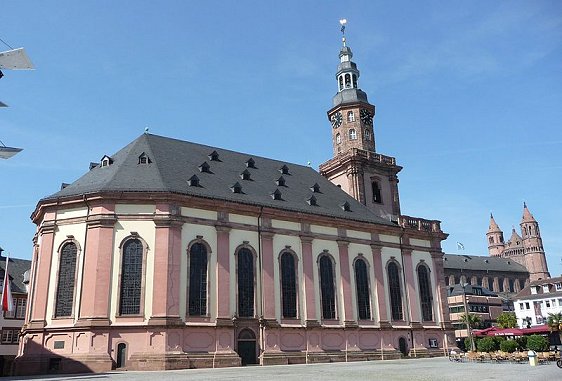Worms is a small town in Rhineland-Palatinate, in Germany. It covers 108.73 sq km (41.98 sq mi) and has a population of 82,000 (2011 estimate). The town is in the Central European Time Zone (UTC+1) and in summer the Central European Summer Time Zone (UTC+2).
Worms is located at an elevation of 81 m (282 ft) to 167 m (548 ft), on the west bank of the river Rhine, between Ludwigshafen and Mainz. It comprises the town center and thirteen districts or quarters, namely Abenheim, Heppenheim, Herrnsheim, Hockheim, Horchheim, Ibersheim, Leiselheim, Neuhausen, Pfeddershem, Pfiffligheim, Rheindürkheim, Weinsheim and Wiesoppenheim.
 Dreifaltigkeitskirche, Worms
Dreifaltigkeitskirche, WormsSource: https://commons.wikimedia.org/wiki/File:Dreifaltigkeitskirche_Worms_01.jpg
Author: Immanuel Giel

Worms, which means "watery area" in Celtic, is one of the oldest towns in Germany, having been establish even before the Romans arrived in the area. Its original Celtic name was Borbetomagus. It was known by that name under Roman rule. The Romans laid out a town in the Roman style, complete with temples to their gods such as Jupiter, Minerva and Mars.
Roman rule over Worms was replaced by Frankish rule. The city may have embraced the Catholic faith as early as AD 346, when a Worms bishopric was first mentioned. Worms Cathedral, begun in the 11th century, is one of the largest and finest churches of the Romanesque architectural style in Germany. The cathedral has been revamped over the centuries, with later additions being of the Gothic style.
During the High Middle Ages, Worms was one of the most important towns within the Holy Roman Empire. It was the site of the imperial parliament, or Reichtag, where over a hundred parliamentary assemblies, or Diets, was held. The most historically significant was the session in 1521, which issued the Edict of Worms, declaring Martin Luther an outlaw for refusing to recant his religious belief.
There has been a Jewish community in Worms going back to medieval times. It was quite likely to have been established in the late 10th or early 11th century. The Jewish Cemetery in Worms is the oldest in Europe. Apart from a massacre of Jews in 1096, in the hands of the crusaders, the Jews were left to live in peace in Worms until the Nazis launched the Kristallnacht attack in 1938.
The Jewish Quarter was destroyed and never regained its ersewhile character, although many of the buildings there were rebuilt to original state in the 1970s and 80s. Another anti-Jew incident manifested itself as recently as 2010, when a Molotov cocktail was hurled at the window of Worm's synagogue.
Today Worms is a tourist town with numerous historical sights. It receives mostly domestic tourists from around Germany.
Visiting Worms
You can reach Worms by train from Frankfurt, Mainz or Mannheim.Places of Interest in Worms
- Dom St Peter: St Peter's Cathedral, also called the Cathedral of Worms, dates to the 11th century, but was in fact reconstructed in 1886-1935.
- Dreifaltigkeitskirche: The Church of the Holy Trinity, located near the cathedral, is another interesting church in Worm's market square.
- Heiliger Sand: Literally Holy Sand, this is the oldest Jewish cemetery in Europe.
- Liebfrauenkirche: The Church of Our Lady is a 14th century Roman Catholic church.
- Magnuskirche: 11th century church with its crypt dating to AD 800.
- Rotes Haus: The Red House is the only surviving Renaissance residential house in Worms.
- Stiftskirche St Martin: Collegiate Church of St Martin dates from the 11th century.
- Stiftskirche St Paul: Church of St Paul, a collegiate church dating to the 11-12th centuries.
- Tower Gate of the Nibelungen Bridge: Medieval gate on the bridge across the river Rhine approaching Worms.
- Worms Synagogue: Also called Rashi's Chapel, this is the oldest existing synagogue in Germany.
 Latest updates on Penang Travel Tips
Latest updates on Penang Travel Tips

Copyright © 2003-2025 Timothy Tye. All Rights Reserved.

 Go Back
Go Back